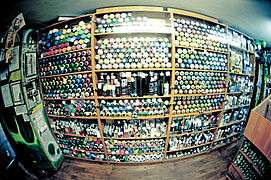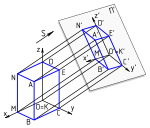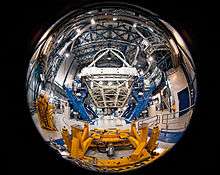Fisheye lens

A fisheye lens is an ultra wide-angle lens that produces strong visual distortion intended to create a wide panoramic or hemispherical image.[1][2] Fisheye lenses achieve extremely wide angles of view by forgoing producing images with straight lines of perspective (rectilinear images), opting instead for a special mapping (for example: equisolid angle), which gives images a characteristic convex non-rectilinear appearance.
The term fisheye was coined in 1906 by American physicist and inventor Robert W. Wood based on how a fish would see an ultrawide hemispherical view from beneath the water (a phenomenon known as Snell's window).[2][3] Their first practical use was in the 1920s for use in meteorology[4][5] to study cloud formation giving them the name "whole-sky lenses". The angle of view of a fisheye lens is usually between 100 and 180 degrees[1] while the focal lengths depend on the film format they are designed for.
Mass-produced fisheye lenses for photography first appeared in the early 1960s[6] and are generally used for their unique, distorted appearance. For the popular 35 mm film format, typical focal lengths of fisheye lenses are between 8 mm and 10 mm for circular images, and 15–16 mm for full-frame images. For digital cameras using smaller electronic imagers such as 1/4" and 1/3" format CCD or CMOS sensors, the focal length of "miniature" fisheye lenses can be as short as 1 to 2mm.
These types of lenses also have other applications such as re-projecting images filmed through a fisheye lens, or created via computer generated graphics, onto hemispherical screens. Fisheye lenses are also used for scientific photography such as recording of aurora and meteors, and to study plant canopy geometry and to calculate near-ground solar radiation. They are also used as peephole door viewers to give the user a wide field of view.
Uses in photography
In a circular fisheye lens, the image circle is inscribed in the film or sensor area; in a full-frame fisheye lens the image circle is circumscribed around the film or sensor area.
Further, different fisheye lenses distort images differently, and the manner of distortion is referred to as their mapping function. A common type for consumer use is equisolid angle.
Although there are digital fisheye effects available both in-camera and as computer software they can't extend the angle of view of the original images to the very large one of a true fisheye lens.
Circular fisheye
The first types of fisheye lenses to be developed were "circular fisheye" — lenses which took in a 180° hemisphere and projected this as a circle within the film frame. Some circular fisheyes were available in orthographic projection models for scientific applications. These have a 180° vertical angle of view, and the horizontal and diagonal angle of view are also 180°. Most circular fisheye lenses cover a smaller image circle than rectilinear lenses, so the corners of the frame will be completely dark.
Full-frame fisheye

As fisheye lenses gained popularity in general photography, camera companies began manufacturing fisheye lenses that enlarged the image circle to cover the entire rectangular frame, called a "full-frame fisheye".[7]
The picture angle produced by these lenses only measures 180 degrees when measured from corner to corner: these have a 180° diagonal angle of view, while the horizontal and vertical angles of view will be smaller; for an equisolid angle-type 15 mm full-frame fisheye, the horizontal FOV will be 147°, and the vertical FOV will be 94°.[8]
The first full-frame fisheye lens to be mass-produced was a 16 mm lens made by Nikon in the early 1970s. Digital cameras with APS-C sized sensors require a 10.5 mm lens (or, for Canon APS-C cameras, a 10 mm lens) to get the same effect as a 16 mm lens on a camera with full-frame sensor.[9]
Focal length
Sigma currently makes a 4.5mm fisheye lens that captures a 180-degree field of view on a crop body.[10] Sunex also makes a 5.6mm fisheye lens that captures a circular 185-degree field of view on a 1.5x Nikon and 1.6x Canon DSLR cameras.

Nikon produced a 6 mm circular fisheye lens that was initially designed for an expedition to Antarctica. It featured a 220-degree field of view, designed to capture the entire sky and surrounding ground when pointed straight up. This lens is no longer manufactured by Nikon,[11] and is used nowadays to produce interactive virtual-reality images such as QuickTime VR and IPIX. Because of its very wide field of view, it is very large and cumbersome—weighing 5.2 kilograms (11 lb), having a diameter of 236 millimetres (9.3 in), a length of 171 millimetres (6.7 in) and an angle of view of 220 degrees. It dwarfs a regular 35 mm SLR camera[12] and has its own tripod mounting point, a feature normally seen in large long-focus or telephoto lenses to reduce strain on the lens mount because the lens is heavier than the camera. The lens is extremely rare,[13] however, there a new developments by the Japanese manufacturer Entaniya for the Micro Four Thirds standard, which offer an angle of view of 250 degrees with lenses that have a focal length of 2.3 millimetres (0.091 in) to 3.6 millimetres (0.14 in), a lens speed of f/2.8 to f/4.0, a weight of 1.6 kilograms (3.5 lb), a diameter of 120 millimetres (4.7 in) and a length below 100 millimetres (3.9 in).[14]
An 8 mm fisheye lens, also made by Nikon, has proven useful for scientific purposes because of its equidistant (equiangular) projection, in which distance along the radius of the circular image is proportional to zenith angle.
The fastest commercially available fisheye lens with autofocus is the Olympus M.Zuiko Digital ED 8 mm f/1.8 Fisheye Pro for system cameras of the Micro Four Thirds system. In this camera system there are also fisheye lenses with a field
Fisheye lenses for APS-C cameras
- Pentax DA 10-17mm lens (F3.5-4.5) / Tokina AF 10-17mm f/3.5-4.5 AT-X DX
- Samyang 8mm f3.5 fisheye. Notable for its stereographic projection.
- Sigma 10mm F2.8 EX DC Fisheye HSM lens
- Nikon AF DX Fisheye-Nikkor 10.5mm f/2.8G ED
- Sigma 4.5 mm f/2.8 EX DC Circular Fisheye HSM for APS-C sensors
Fisheye lenses for 35 mm cameras
Circular fisheye

- Peleng 8 mm f/3.5
- Sigma 8 mm f/4.0 EX DG
- Sigma 8 mm f/3.5 EX DG - replaces the Sigma 8 mm f/4.0 EX DG
Full-frame fisheye
- Canon EF 15 mm f/2.8 (discontinued)
- Canon Fisheye FD 15mm f/2.8 (old lens, does not work on EF mount)
- Minolta AF 16mm f/2.8 Fisheye lens
- Sigma 15mm f/2.8 EX DG Diagonal Fisheye
- Fisheye-Nikkor AF 16mm f/2.8 D
- Samyang 12mm f/2.8 ED AS NCS Diagonal Fish-eye
Zoom fisheye
- Canon EF 8–15mm f/4L Fisheye USM – lens can be used as both a full-frame fisheye and a circular fisheye on a 35 mm full-frame film or DSLR such as the canon 5d (Mark I – III) cameras, it can only be used as a cropped circular or as a full-frame fisheye on EOS DSLRs with APS-C/H size sensors (a zoom lock is included).
- Tokina AT-X 10–17mm f3.4-4.5 AF DX – a fisheye zoom lens designed for APS-C sensor cameras. It's also sold as a NH version that comes without integrated lens hood, then the fisheye lens is usable on full frame cameras. The lens is also sold under Pentax brand.
- Pentax SMC Pentax-F Fish-Eye 1:3.5–4.5 17–28mm – lens was born for full-frame film cameras, to take the place of the 16mm f/2.8 in the AF era. It starts from a 17mm full-frame fisheye and reaches the end of the excursion as an overdistorted 28mm. Was intended as a "special effect" lens and never had big sales.[15]
Miniature fisheye lenses
Miniature digital cameras, especially when used as security cameras, often tend to have such lenses for similar reasons. Miniature fisheye lenses are designed for small-format CCD/CMOS imagers commonly used in consumer and security cameras.[16][17] Popular format sizes are 1/4" (active area 3.6mmx2.7mm), 1/3" (active area 4.8mmx3.6mm) and 1/2" (active area 6.6mmx4.8mm). Depending on the imager active area, the same lens can form a circular image on one imager (e.g. 1/2"), and a full frame on the other (e.g. 1/4").
Sample images

 Fisheye used to capture entire Wells Cathedral Chapter House room
Fisheye used to capture entire Wells Cathedral Chapter House room Canon 8–15mm zoom at 8mm of BMW M3
Canon 8–15mm zoom at 8mm of BMW M3 Image shot with a 16mm full-frame fisheye lens before and after remapping to rectilinear perspective.[n 1]
Image shot with a 16mm full-frame fisheye lens before and after remapping to rectilinear perspective.[n 1]
Other applications
- Many planetariums now use fisheye projection lenses to project the night sky or other digital content onto the interior of a dome.
- Flight simulators and visual combat simulators use fisheye projection lenses in order to create an immersive environment for pilots, air traffic controllers, or military personnel to train in.
- Similarly, the IMAX Dome (previously 'OMNIMAX') motion-picture format involves photography through a circular fisheye lens, and projection through the same onto a hemispherical screen.
- Scientists and resource managers (e.g., biologists, foresters, and meteorologists) use fisheye lenses for hemispherical photography to calculate plant canopy indices and near-ground solar radiation. Applications include evaluation of forest health, characterization of monarch butterfly winter roosting sites, and management of vineyards.
- Astronomers use fisheye lenses to capture cloud cover and light pollution data.
- Photographers and videographers use fisheye lenses so they can get the camera as close as possible for action shots whilst also capturing context, for example in skateboarding to focus on the board and still retain an image of the skater.
- The first music video to be shot completely with fisheye lens was for the Beastie Boys song "Hold It Now, Hit It" in 1987.
- In Computer Graphics, circular fisheye images can be used to create environment maps from the physical world. One complete 180-degree wide angle fisheye image will fit to half of cubic mapping space using the proper algorithm. Environment maps can be used to render 3D objects and virtual panoramic scenes.
Mapping function
The mapping of a sideways object leads to a picture position displacement from the image center. The manner of this conversion is the mapping function. The distance of a point from the image center 'r' is dependent on the focal length of the optical system 'f', and the angle from the optical axis 'θ', where 'θ' is in radians.
 Original tunnel to be photographed, with camera looking from inside center to left wall.
Original tunnel to be photographed, with camera looking from inside center to left wall.
Normal (non-fisheye) lens
 Gnomonical
Gnomonical Gnomonical, 40° right pan
Gnomonical, 40° right pan
- Gnomonical (perspective): . Works like the pinhole camera. Straight lines remain straight (distortion free). has to be smaller than 90°. The aperture angle is gaged symmetrically to the optical axis and has to be smaller than 180°. Large aperture angles are difficult to design and lead to high prices.
Fisheye lens
Fisheye lenses can have many different mapping functions:[19]
 Stereographic
Stereographic Equidistant
Equidistant Equisolid angle
Equisolid angle Orthographic
Orthographic
- Stereographic (conform): . Maintains angles. This mapping would be ideal for photographers because it doesn't compress marginal objects as much. Samyang is the only manufacturer to produce this kind of fisheye lens, but it is available under different brand names. This mapping is easily implemented by software.
- Equidistant (linear scaled): . Maintains angular distances. Practical for angle measurement (e.g., star maps). PanoTools uses this type of mapping.
- Equisolid angle (equal area): . Maintains surface relations. Every pixel subtends an equal solid angle, or an equal area on the unit sphere. Looks like a mirror image on a ball, best special effect (unsophisticated distances), suitable for area comparison (clouds grade determination). This type is popular but it compresses marginal objects. The prices of these lenses are high, but not extreme.
- Orthographic: . Maintains planar illuminance. Looks like an orb with the surroundings lying on < max. 180° aperture angle.
- Other mapping functions (for example Panomorph Lenses) are also possible for enhancing the off-axis resolution of fisheye lenses.
With appropriate software, the curvilinear images produced by a fisheye lens can be remapped to a conventional rectilinear projection. Although this entails some loss of detail at the edges of the frame, the technique can produce an image with a field of view greater than that of a conventional rectilinear lens. This is particularly useful for creating panoramic images.
All types of fisheye lenses bend straight lines. Aperture angles of 180° or more are possible only with large amounts of barrel distortion.
See also
| Part of a series on |
| Graphical projection |
|---|
 |
Notes
- ↑ Camera: a 35mm-format digital SLR, editing tool: Panorama Tools
References
- 1 2 Henry Horenstein (2005-04-20). Black and White Photography: A Basic Manual. p. 55. ISBN 9780316373050.
- 1 2 Rudolf Kingslake (1989-10-28). A history of the photographic lens. p. 145. ISBN 9780124086401.
- ↑ "Philosophical Magazine".
- ↑ David Brooks (1982). Lenses and lens accessories: a photographer's guide. p. 29. ISBN 9780930764340.
- ↑ Hill, R. 1924. A lens for whole sky photographs. Quarterly Journal of the Royal Meteorological Society 50:227-235.
- ↑ "The New Nikon Compendium".
- ↑ "The Magic of Digital Nature Photography".
- ↑ The formula is which comes from inverting the mapping function; Dyxum, Gustavo Orensztajn
- ↑ "Cameras from Nikon - DSLR and Digital Cameras, Lenses, & More".
- ↑ 4.5mm F2.8 EX DC Circular Fisheye HSM
- ↑ "Additional Information on Fisheye-Nikkor 6mm f/2.8 lens". Malaysian Internet Resources. Retrieved 2008-11-11.
- ↑ "Additional Information on Fisheye-Nikkor 6mm f/2.8 lens: Late 70s". Malaysian Internet Resources. Retrieved 2008-11-11.
- ↑ Laurent, Olivier Laurent (23 April 2012). "Rare extreme wide-angle Nikkor lens goes on sale". British Journal of Photography. Retrieved 24 April 2012.
- ↑ Entaniya Fisheye 250 MFT - Micro Four Thirds system lens - 250° Fisheye Lens, entapano.com, retrieved on 15 November 2016
- ↑ "TheFishList - Pentax DA 10-17 -".
- ↑ 190 Degree FOV Miniature Fisheye Lens
- ↑ Miniature fisheye lenses
- ↑ "The Curves of ESO's Headquarters". ESO Picture of the Week. Retrieved 26 February 2014.
- ↑ "Samyang 8 mm f/3.5 Aspherical IF MC Fish-eye review - Introduction - Lenstip.com".
External links
| Wikimedia Commons has media related to Fisheye lenses. |
- Fisheye projection theory
- A list of fisheye lenses
- Overview of fish-eye distortion effects
- Various fisheye projections

